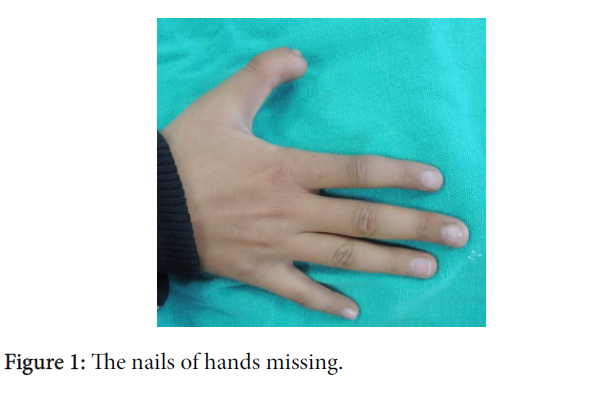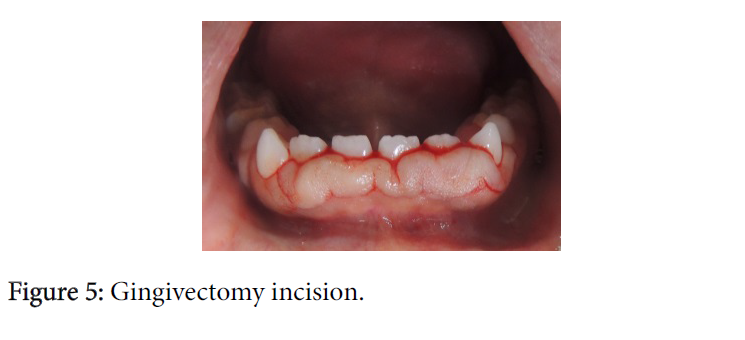Zimmermann-Laband syndrome: A Rare Case Report
Received: 30-Apr-2018 / Accepted Date: 12-Jun-2018 / Published Date: 18-Jun-2018
Abstract
Zimmermann-Laband syndrome (ZLS) is a very rare condition characterized by gingival fibromatosis, coarse facial appearance and malformed nails or distal phalanges of hands/feet and sometimes hepatosplenomegaly [1]. The term Zimmermann-laband syndrome was for the first time given by Carl Jacob Witkop. It is attributed to be because of autosomal disease characterized by a classical triad of extensive gingival enlargement (gingival fibromatosis), abnormalities of the nose and ears, abnormaly developed nails or terminal phalanges of the hands and feet. The present case report is of a 12 year old boy who was diagnosed as ZLS based on the classical sign of gingival overgrowth.
Keywords: Labands syndrome; Gingival overgrowth; Nail dysplasia; Gingivectomy
Introduction
Laband syndrome is a very rare autosomal dominant, genetic disorder characterized by malformation of the hands and feet and orally characterised by gingival overgrowth [1,2].
The clinical features include coarse facial appearance, bulbous soft nose, thick lips, soft elongated ears which may be thick and gingival fibromatosis. The syndrome has many variations clinically, some features include hyperextensibility of joints, enlarged liver and spleen, hypertrichosis. The excessive gingival tissue can affect the aesthetics and function of the individual. This requires a surgical intervention most of the times.
Case Report
A 12 year old male child reported to the hospital with the chief complaint of increase in thickness of the gums in the lower anterior region causing difficulty in chewing and giving an unpleasant smile. On eliciting the history revealed that the increase in size was gradual and had reached the present size. The patient did not reveal any familial history. The child was otherwise systemically healthy, not on any medication for any known reason.
On general examination of the patient revealed the presence of thick eyebrows, bulbous nose and increase in the size of the lips. The hands showed the absence of nails in the fingers. The nails of the toes were also missing (Figures 1 and 2).
The examination of extremities showed irregularity in the size of both the feet (Figure 3).
Intraoral examination revealed severe gingival overgrowth in the lower anterior region with macroglossia and shallow square palate. The overgrowth was firm and fibrous in consistency. More in the lower anterior region. Mild increase in size in the posterior, all four quadrants were involved. Psuedo pockets were seen in the anterior mandibular teeth. Minimal bleeding on probing was also present.
A panoramic radiograph was taken. It showed a mixed dentition stage with teeth arranged irregularly (Figure 4). The routine blood investigation and urine examination revealed findings which were within the normal range. Ultrasonography showed no signs of any abnormality in the size of liver as well as the spleen and patient was systemically healthy. The 12 year old child was diagnosed with Zimmermann-Laband syndrome which was confirmed based on the clinical features and physical examination.
Treatment was planned based on the chief complaint, initial therapy included deep scaling followed by gingivectomy to improve aesthetics and function. A classical reverse bevel gingivectomy (Figures 5 and 6) was performed under 2% lidocaine (local anaesthesia) the excised tissue sample was sent for histological analysis (Figure 7). Periodontal pack (Coe pack) was placed. Patient was prescribed with an mild analgesic (paracetamol) and an antiseptic mouth wash (0.12% chlorhexidine gluconate) for 10 days.
Histological examination of gingival tissue excised showed hypertrophy of stratified squamous epithelium with elongated rete pegs. Compressed blood vessels were seen due to increased collagen. No evidence of dysplasia was noted. The patient was periodically recalled for maintenance therapy (Figure 8).
Discussion
A rare syndrome known as Zimmermann-Laband syndrome or Laband’s syndrome was first reported by Zimmermann (1928). It is an autosomal dominant disease characterized by a triad of extensive gingival enlargement (gingival fibromatosis) (Figure 9), abnormalities of the nose and ears, absence or hyperplasia of the nails or terminal phalanges of the hands and feet. Other findings include splenomegaly, hepatomegaly, and hyper extensible metacarpophalangeal joints. Intellectual deficit is occasional and usually mild to moderate. The genetic changes are unknown. Studies have shown two translocations t(3;8) and t(3;17) found in two patients with ZLS [3]. Forty-four patients have been reported till 2010.
The most common and consistent feature of ZLS is gingival overgrowth appearing in early childhood. This condition is not often seen at birth [4]. In the diagnosis, systemic evaluation is necessary to differentiate gingival fibromatosis from various other types of acquired generalized gingival overgrowths that can occur as a result of inflammation, pregnancy, leukaemia, and drug induced gingival overgrowth caused by phenytoin, diltiazem, cyclosporine, verapamil, and nifedipine. In such cases, the gingiva is usually not as enlarged or as fibrotic as in hereditary gingival fibromatosis [5].
Sawaki et al. [6] elicited the clinical features of ZLS as gingival overgrowth, hyperplasia or absence of the nails of hand and feet, bulbous soft nose, thickened lips, elongated ear. Other Syndromes such as Murray-Puretic-Drescher present with numerous hyaline fibromas, osteolysis of terminal phalanges, recurrent infection, stunted growth, and early death. It is partially similar to Jones Syndrome, an genetically inherited disease first described in 1977 [7]. Jones syndrome is associated with slow deafness. In cases where gingival fibromatosis is associated with nasal as well as nail defects it may be characterized as ZLS. Our patient did not show embedded supernumerary teeth, unlike Wynne et al. [8] in 1995 who reported gingival fibromatosis associated with hearing deficit and supernumerary teeth.
Treatment in cases with ZLS is gingivectomy and orthodontic intervention where, ever required to improve aesthetic appearance and eruption of the non-erupted teeth. Gingivectomy can be carried out using the classical reverse bevel gingivectomy, as done in this case or by the help of lasers [9].
Recurrence is very common; hence prognosis is fair. Periodic physical/systemic evaluation is very essential.
Conclusion
The Zimmermann-Laband syndrome is never life-threatening. The present case case was diagnosed due to gingival overgrowth and a thorough clinical examination. Dentists too can sometimes play a very important role in identification of certain life-threatening syndromes.
References
- Atabek ME, Pirgon O, Sert A, Toy H (2005) Zimmermann-Laband syndrome in an infant with an atypical histologic finding. Pediatr Dev Pathol 8: 654-657.
- Coletta RD, Graner E (2006) Hereditary gingival fibromatosis: A systemic review. J Periodontal 77:753-64.
- Kim HG, Higgins AW, Herrick SR, Kishikawa S, Nicholson L, et al. (2007) Candidate loci for Zimmermann-Laband syndrome at 3p14.3. Am J Med Genet A 143:107-11.
- Breen GH, Addante R, Black CC (2009) Early onset of hereditary gingival fibromatosis in a 28-month-old. Pediatr Dent 31: 286-288.
- Holzhausen M, Ribeiro FS, Gonçalves D, Corrêa FO, Spolidorio LC, et al. (2005) Treatment of gingival fibromatosis associated with Zimmermann-Laband syndrome. J Periodontol 76: 1559-62.
- Sawaki K, Mishima K, Sato A, Goda Y, Osugi A, et al. (2012) Zimmermann-Laband syndrome: A case report. J Clin Pediatr Dent 36: 297-300
- Jones G, Wilroy RS Jr, McHaney V (1977) Familial gingival fibromatosis associated with progressive deafness in five generations of a family. Birth Defects Orig Artic Ser 13: 195-201.
- Wynne SE, Aldred MJ, Bartold PM (1995) Hereditary gingival fibromatosis associated with hearing loss and supernumerary teeth: a new syndrome. J Periodontol 66: 75-79.
- Pick RM, Pecaro BC (1987) Use of the CO2 laser in soft tissue dental surgery. Lasers Surg Med 7:207-13.
Citation: Lal V, Panwar M, Kumar S, Kosala M (2018) Zimmermann-Laband Syndrome: A Rare Case Report. J Interdiscipl Med Dent Sci 6: 235.
Copyright: © 2018 Lal V, et al. This is an open-access article distributed under the terms of the Creative Commons Attribution License, which permits unrestricted use, distribution, and reproduction in any medium, provided the original author and source are credited.
Share This Article
Recommended Journals
Open Access Journals
Article Usage
- Total views: 4414
- [From(publication date): 0-2018 - Apr 21, 2025]
- Breakdown by view type
- HTML page views: 3567
- PDF downloads: 847









